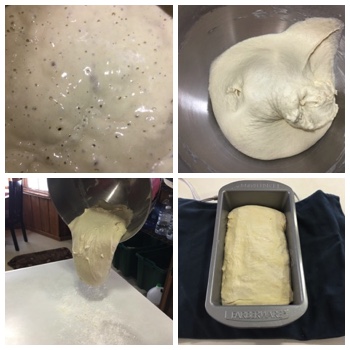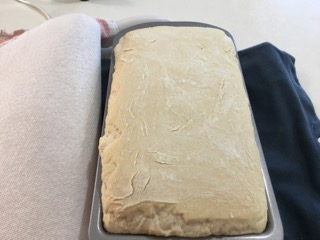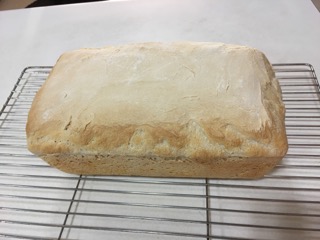 One of our favorite ferments is our recently-resurrected sourdough starter. It began as a dry powder, but with consistent feedings, has become a reliable producer of delicious sourdough loaves – no yeast needed!
One of our favorite ferments is our recently-resurrected sourdough starter. It began as a dry powder, but with consistent feedings, has become a reliable producer of delicious sourdough loaves – no yeast needed!
Making a loaf starts with mixing the starter, which should be bubbly and sour-smelling, with water, salt and flour. The stand mixer does a marvelous job of creating the right elasticity, and once properly mixed, the dough is poured out onto a floured surface to be shaped into a loaf. After filling the loaf pan, the dough is covered and left to rise. With the cold temperatures, we find that letting it rise on a heating pad on the low setting really helps.
Once risen, the loaf goes into the oven and bakes until it’s golden brown. 
As it does, the house is filled with the unmistakably tantalizing smell of baking bread. When the baking is complete, the crusty loaf is turned out of the pan onto a rack to cool (we have to restrain ourselves from cutting into it right away). When it’s cooled, it makes slightly chewy, delicately tangy slices ready for sandwiches or to become the most perfect toast possible: crispy on the outside an chewy on the inside.
 It’s gratifying to have a beautiful loaf as the fruit of your efforts, since the first few loaves were pretty dense and brick-like. Practice (and the right flour) really seems to make a better loaf. After a while, you understand if the starter and dough looks “right”, and when it’s risen properly. You also learn how to compensate for factors like cool indoor temperatures, so that the starter remains active and ready to go.
It’s gratifying to have a beautiful loaf as the fruit of your efforts, since the first few loaves were pretty dense and brick-like. Practice (and the right flour) really seems to make a better loaf. After a while, you understand if the starter and dough looks “right”, and when it’s risen properly. You also learn how to compensate for factors like cool indoor temperatures, so that the starter remains active and ready to go.
Like other ferments, the sourdough starter must be fed regularly; in Audrey’s case, it’s a daily feeding. We want to keep her happy so we can continue to eat what has become our favorite bread. When Audrey’s happy, we’re happy!
